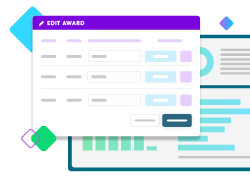The Myth of Risk: Fear Not the Dragons, Funders

I have been on this quest for some time, sharing the message that there is no bad grant. But like a band of adventurers rallying others to join them on their epic journey, it is going to take some time (and coaching) to help funders reframe risk conversations to be about providing a safety net to their grantee rather than a gotcha moment.
In the spirit of mythology, let us travel to a world inspired by one of my favorite authors, J.R.R. Tolkien. In the latest telling:
Galadriel has a shaky relationship with the Elven leaders; she is unwilling to believe that evil has been completely vanquished and ultimately decides not to sail with the other Elven warriors to Valinor.
In my retelling, we travel to the present day, where:
Gal has a shaky relationship with her program officers; she is unwilling to believe that risk has been completely vanquished and ultimately decides not to follow with the other Grantmaking warriors to Trust-Based Philanthropy—a mythic, enticing world where funders live in true partnership and trust with nonprofits and communities.
Heroes emerge, who recognize that a strong grants management function leads to a funder’s ability to operate more equitably, with nimble practices rightsized and appropriate to the nonprofits and communities it seeks to support. Many band together, such as those in the PEAK Grantmaking community, which centers on advocating and empowering grants management as a role and function.
In our world, many funders view their most significant role at work as guarding the treasure by avoiding perceived peril. Though the outcomes and outputs rest not in their hands—but those we might empower—there is a reticence to fully believe in the ability of the nonprofits to even finish the trek!
From Guardian to Warrior: Responsive Grantmaking
When we were creating our five core principles for Peak Grantmaking, the working group landed on Steward Responsively as our fourth. What? Don’t we mean responsibly? No. Responsible means being morally accountable for one’s action, while being responsive implies the ability to react quickly with positive outcomes for all. Who can’t get behind that notion (even if we have to write a ton of blogs to explain the difference)?
Responsible: World on the shoulders. Guardian at the gate. Danger!
Responsive: Light on the feet. Warrior at the ready. Winning!
Consider risk from a nonprofit perspective: Whether perceived or real, a funder’s perception of risk impacts how they raise money, which, in turn, impacts everything. So, using seemingly innocuous adjectives like “new” and “small” can trigger the most defensive of postures.
In a recent discussion that included Adriana Jiménez, PEAK’s former board co-chair, she spoke about how some nonprofits have chosen to be small or nontraditional because it’s the best model for them to advance their mission. But for funders that begin their quest worried about whether the size of staff or organization of a potential grantee implies an inability to execute, the funder might instead pass the organization by and miss an amazing partnership opportunity.
If “small” and “new” are triggering to some, consider what “grassroots,” “Black-led,” and “queer activist” descriptors conjure for those foundations whose grantmaking practices and dollars have primarily backed white cisgender-led 501(c)3 nonprofits.
In a recent study issued by The Urban Institute’s Center for Nonprofits and Philanthropy, we continue to see lags in grant size for only the nonprofits with those nontraditional descriptors. Moreover, the Association for Fundraising Professionals and many others have consistently reported that female-identifying development managers hear “no” to funding requests more frequently than their male-identifying counterparts, with a similar statistic reported by female nonprofit executives. The coolness in reception to our ideas, concerns that we’re going too far with talk of racial equity, and less funding even when we do get it can definitely signal that there is less faith in the work led by these nonprofit leaders and professionals.
Conquering the Myth of Risk
I continue to work in this sector because I believe in it. There is no monolith of funders or social-sector organizations. I am heartened that the sector seems to have learned from the trials and tests of the past few years, and I see refreshing changes in attitudes and funding practices. But the myth of risk stubbornly persists.
Risk models were not designed for our sector. The businesses that require those models do so to gain an advantage over their competitors, generally for the purpose of profitability. I’m going to echo what Brené Brown does when she narrates her audiobooks. Repeat myself so it sinks in: Risk models were not designed for our sector and those businesses that require their use do so to gain an advantage over their competitors, generally for the purpose of profitability. As someone who sat on the side of the funder angels for many years, the lack of spirit in that purpose completely misses the mark for those of us with the heart and soul for this work.
If your foundation has established risk assessments and begins funding discussions with a “low-risk” tolerance, is that about you or the nonprofits? Is it because your organization has made a series of investments to failing nonprofits, or ones whose results repeatedly fell short of expectations? The funders I know have few of those tales. So, why not let down the guard and dispense with the notion that the right role is to control access to the treasure and protect against all perceived perils. Instead, with each grant decision, might you welcome the opportunity to take a fresh look and lend a fair chance to a new potential partner in the work? And while we’re at it, how about we just retire the term “risk assessment”?
Removing the Moats Around Stewardship
Returning to PEAK’s Steward Responsively Principle, I invite you to focus not on the juxtaposition of responsive versus responsible, but on the term “stewardship.” When some foundations use the term, it translates to “protection.” When nonprofits talk about stewardship, we are referring to “relationships.” To truly steward responsively requires an abundance mindset, not an inclination to caution and scarcity.
We are living in a new world, where technology and innovation have connected us more than ever before. We have more vehicles to communicate our successes and shortcomings. Funder-nonprofit collaboratives abound. Funding institutions play a critical role in financially supporting effective programs, projects, and ideas as well as in creating forums for sector convenings that can break down the walls between us and build true partnerships to advance their collective causes.
Each funder has unique assets to bring to the table as does each nonprofit and social-sector institution. We cannot let our perception drive us away from opportunity; rather, let’s use the tools, technology, and shared visions for change to instead bind us together.
Arthur Ashe said, “Success is a journey, not the destination. The doing is often more important than the outcome.” Changing the world is often about taking big risks, making big bets, and trying things never attempted. Philanthropy has an amazing role to play because the global “we” has yet to figure out how to feed, clothe, and care for our fellow citizens with equity, compassion, and love.
Begin Your Quest (Because Transformation Takes Time)
With that, I implore you to advocate that the castles of philanthropy do not warrant the moats devised to protect its assets. In putting aside notions of risk, nobody is asking funders to climb the castle tower and throw all your loot into the wind and hope the treasure floats toward need. Walk to the village center. Get to know the townspeople. Find out who needs what, which solutions are working, and who’s already doing the good work or poised to take up that quest. Align your goals with their skills, make the investment, and remember that doing transformational things takes time.
The dragons are not real. Let’s not let perceived risks hold us back from the amazing journey that lies ahead.
Learn more about responsive stewardship and building relationships with grantees by checking out our webinar, Are You Stewarding Responsively? The Art of Managing, Rather Than Mitigating Risk.
Manage your entire grantmaking workflow, from online grant applications through payments
Find out how Blackbaud Grantmaking™ fits your organization.


